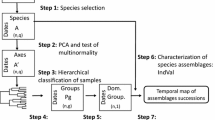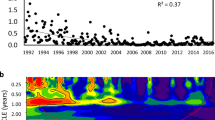Abstract
Phenology and seasonal succession in aquatic ecosystems are strongly dependent on physical factors. In order to promote investigations into this coupling, methods of characterising annual time series of phytoplankton were derived and applied to a 31-year data set from Saidenbach Reservoir (Saxony, Germany). Field data are often scarce and irregularly sampled, particularly in the transition period from winter to spring, so reliable methods of determining cardinal dates in the time series are necessary. The proposed methods were used to determine the beginning, maximum and end of the spring mass development of phytoplankton by estimating the inflexion points (A), fitting a Weibull-type function (B) and fitting linear segments to the logarithmic values (C). For the data set from Saidenbach Reservoir, all three methods proved to be relevant to the analysis of long-term trends. Differences between the maxima determined by the different methods seemed small, but there were deviations when the maximum was related to physical factors such as ice-out. The Weibull-type fit gave the most reliable and comprehensible results and is recommended for trend analyses. For all methods, long-term analysis of the duration of the spring mass development and the duration of the spring full circulation revealed a period of consistently low values (1975–1990) followed by a period of higher values (1990–2005). These periods were also identified for the date of ice-out, although in this case there was a period of high values followed by a period of low values. A sensitivity analysis that compared results from subsampled time series with increasing time intervals indicated that a minimum of one sample every three weeks is needed to obtain reliable results.







Similar content being viewed by others
References
Adrian R, Walz N, Hintze T, Hoeg S, Rusche R (1999) Effects of ice duration on plankton succession during spring in a shallow polymictic lake. Freshw Biol 41(3):621–634
Anneville O, Souissi S, Gammeter S, Straile D (2004) Seasonal and inter-annual scales of variability in phytoplankton assemblages: comparison of phytoplankton dynamics in three perialpine lakes over a period of 28 years. Freshw Biol 49:98–115
Backhaus JO, Hegseth EN, Wehde H, Irigoien X, Hatten K, Logemann K (2003) Convection and primary production in winter. Mar Ecol Prog Ser 251:1–14
Benndorf J, Kranich J, Mehner T, Wagner A (2001) Temperature impact on the midsummer decline of Daphnia galeata: an analysis of long-term data from the biomanipulated Bautzen Reservoir (Germany). Freshw Biol 46:199–211
Blenckner T, Omstedt A, Rummukainen M (2002) A Swedish case study of contemporary and possible future consequences of climate change on lake function. Aquat Sci 64:171–184
Durant JM, Hjermann DO, Anker-Nilssen T, Beaugrand G,Mysterud A, Pettorelli N, Stenseth NC (2005) Timing and abundance as key mechanisms affecting trophic interactions in variable environments. Ecol Lett 8(9):952–958
Edwards M, Richardson AJ (2004) Impact of climate change on marine pelagic phenology and trophic mismatch. Nature 430:881–884
Gerten D, Adrian R (2000) Climate-driven changes in spring plankton dynamics and the sensitivity of shallow polymictic lakes to the North Atlantic Oscillation. Limnol Oceanogr 45(5):1058–1066
Gerten D, Adrian R (2001) Differences in the persistency of the North Atlantic Oscillation signal among lakes. Limnol Oceanogr 46(2):448–455
Hamed KH, Rao AR (1998) A modified Mann–Kendall trend test for autocorrelated data. J Hydrol 204(1–4):182–196
Horn H (2003a) The relative importance of climate and nutrients in controlling phytoplankton growth in Saidenbach reservoir. Hydrobiologia 504:159–166
Horn W (2003b) Long-term development of the crustacean plankton in the Saidenbach reservoir (Germany)—changes, causes, consequences. Hydrobiologia 504:185–192
Horn H, Horn W (1993) Sedimentary losses in the reservoir Saidenbach: flux and sinking velocities of dominant phytoplankton species. Int Revue ges Hydrobiol 78(1):39–57
Horn W, Horn H (1995) Interrelationships between crustacean zooplankton and phytoplankton. Hydrobiologia 307:231–238
Horn H, Horn W (2000) Sedimentation—the main loss factor in waters dominated by diatoms. Results of long-term investigations. Int Rev Hydrobiol 85(2–3):191–208
Horn H, Paul L (1984) Interactions between light situation, depth of mixing and phytoplankton growth during spring period of full circulation. Int Revue ges Hydrobiol 69(4):507–519
Horn H, Uhlmann D (1995) Competitive growth of blue–greens and diatoms (Fragilaria) in the Saidenbach Reservoir, Saxony. Wat Sci Tech 32(4):77–88
Horn W, Horn H, Paul L (1994) Long-term trends in the nutrient input and in-lake concentrations of a drinking water reservoir in a dense populated catchment area (Erzgebirge, Germany). Int Revue ges Hydrobiol 79(2):213–227
Huisman J, Van Oostveen P, Weissing FJ (1999) Critical depth and critical turbulence: two different mechanisms for the development of phytoplankton blooms. Limnol Oceanogr 44(7):1781–1787
Köhler J, Hilt S, Adrian R, Nicklisch A, Kozerski HP, Walz N (2005) Long-term response of a shallow, moderately flushed lake to reduced external phosphorus and nitrogen loading. Freshw Biol 50:1639–1650
Mooij WM, Hülsmann S, Domis LND, Nolet BA, Bodelier PLE, Boers PCM, Pires LMD, Gons HJ, Ibelings BW, Noordhuis R, Portielje R, Wolfstein K, Lammens EHRR (2005) The impact of climate change on lakes in The Netherlands: a review. Aquat Ecol 39(4):381–400
Paul L (2003) Nutrient elimination in pre-dams: results of long-term studies. Hydrobiologia 504:298–295
R Development Core Team (2005) R: a language and environment for statistical computing. R Foundation for Statistical Computing, Vienna, Austria, ISBN 3-900051-07-0, http://www.r-project.org. Cited 8th June 2007
Scheffer M, Straile D, van Nes EH, Hosper H (2001) Climatic warming causes regime shifts in lake foodwebs. Limnol Oceanogr 46:1780–1783
Sommer U, Gliwicz ZM, Lampert W, Duncan A (1986) The PEG-model of seasonal succession of planktonic events in fresh waters. Arch Hydrobiol 106(4):433–471
Straile D (2000) Meteorological forcing of plankton dynamics in a large and deep continental European lake. Oecologia 122(1):44–50
Straile D, Adrian R (2000) The North Atlantic Oscillation and plankton dynamics in two European lakes—two variations on a general theme. Glob Change Biol 6(6):663–670
Straile D, Jöhnk K, Rossknecht H (2003a) Complex effects of winter warming on the physicochemical characteristics of a deep lake. Limnol Oceanogr 48(4):1432–1438
Straile D, Livingstone D, Weyhenmeyer GA, George DG (2003b) The response of freshwater ecosystems to climate variability associated with the North Atlantic Oscillation. In: Hurrell JW, Kushnir Y, Ottersen G, Visbeck M (eds) The North Atlantic Oscillation—climatic significance and environmental impact (AGU Geophysical Monograph Series). American Geophysical Union, Washington, DC, 134:263–279
Venables QN, Ripley BD (1999) Modern applied statistics with S-plus, 3rd edn. Springer, New York
Vollenweider RA (1976) Advances in defining critical loading levels for phosphorus in lake eutrophication. Mem Ist Ital ldrobiol 33:53–83
Walther GR, Post E, Convey P, Menzel A, Parmesank C, Beebee TJC, Fromentin JM, Hoegh-Guldberg O, Bairlein F (2002) Ecological responses to recent climate change. Nature 416:398–395
Weyhenmeyer GA (2001) Warmer winters: are planktonic algal populations in Sweden’s largest lakes affected? Ambio 30(8):565–571
Weyhenmeyer GA, Blenckner T, Pettersson K (1999) Changes of the plankton spring outburst related to the North Atlantic Oscillation. Limnol Oceanogr 44(7):1788–1792 12
Wiltshire KH, Manly BFJ (2004) The warming trend at Helgoland Roads, North Sea: phytoplankton response. Helgoland Mar Res 58(4):269–273
Winder M, Schindler DE (2004) Climate change uncouples trophic interactions in an aquatic ecosystem. Ecology 85(8):2100–2106
Yue S, Wang C (2004) The Mann–Kendall test modified by effective sample size to detect trend in serially correlated hydrological series. Water Resour Manage 18(3):201–218
Zeileis A, Leisch F, Hornik K, Kleiber C (2002) strucchange: An R package for testing for structural change in linear regression models. J Stat Softw 7(2):1–38 13
Zeileis A, Kleber C, Krämer W, Hornik K (2003) Testing and dating of structural changes in practise. Comput Stat Data Anal 44(1–2):109–123
Acknowledgments
This study is supported by the German Research Foundation (DFG) under grant (PA 1202/1) of priority programme 1162 AQUASHIFT. The authors are grateful to Karsten Rinke and Stephan Hülsmann for fruitful discussions, Otto Richter for bringing up the Weibull function, and two anonymous referees for their detailed, persevering and constructive suggestions and their encouragement of the sensitivity analysis.
Author information
Authors and Affiliations
Corresponding author
Additional information
Communicated by Ulrich Sommer.
Priority program of the German Research Foundation–contribution 16.
Electronic supplementary material
Below is the link to the electronic supplementary material.
Rights and permissions
About this article
Cite this article
Rolinski, S., Horn, H., Petzoldt, T. et al. Identifying cardinal dates in phytoplankton time series to enable the analysis of long-term trends. Oecologia 153, 997–1008 (2007). https://doi.org/10.1007/s00442-007-0783-2
Received:
Accepted:
Published:
Issue Date:
DOI: https://doi.org/10.1007/s00442-007-0783-2




